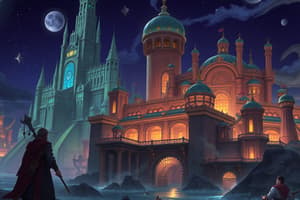Podcast
Questions and Answers
Approximately how long does it take for the Moon to progress through all eight of its phases?
Approximately how long does it take for the Moon to progress through all eight of its phases?
- About 14 days
- Approximately 29.5 days (correct)
- Roughly 7 days
- Around 365 days
What primary factor causes the different phases of the Moon that we observe from Earth?
What primary factor causes the different phases of the Moon that we observe from Earth?
- Variations in the Moon's albedo [reflectivity].
- The Earth's shadow falling on the Moon.
- The changing angles between the Earth, Moon and Sun that affect the illuminated portion visible from Earth. (correct)
- The Moon's distance from the Earth.
In the Northern Hemisphere, during which crescent phase does the illuminated part appear on the right side?
In the Northern Hemisphere, during which crescent phase does the illuminated part appear on the right side?
- New Crescent
- Waxing Crescent (correct)
- Waning Crescent
- Full Crescent
Which phase comes after the Third Quarter and leads back to the New Moon?
Which phase comes after the Third Quarter and leads back to the New Moon?
During which phase does the visible illuminated area of the Moon increase from 50% to nearly 100%?
During which phase does the visible illuminated area of the Moon increase from 50% to nearly 100%?
In what phase is the Moon when it is positioned between the Earth and the Sun?
In what phase is the Moon when it is positioned between the Earth and the Sun?
In the Waning Gibbous phase, which portion of the Moon begins to decrease in illumination immediately after the full moon?
In the Waning Gibbous phase, which portion of the Moon begins to decrease in illumination immediately after the full moon?
Which of the phases presents the left half of the Moon illuminated?
Which of the phases presents the left half of the Moon illuminated?
Just before the New Moon, a thin crescent of light appears on what side of the Moon in the Waning Crescent phase?
Just before the New Moon, a thin crescent of light appears on what side of the Moon in the Waning Crescent phase?
The Waxing Gibbous phase is best described as the period when the Moon's illumination is:
The Waxing Gibbous phase is best described as the period when the Moon's illumination is:
If tonight the moon rises around 9 PM and sets around 9 AM, which phase is the moon currently in?
If tonight the moon rises around 9 PM and sets around 9 AM, which phase is the moon currently in?
During which phase is the entire side of the Moon facing Earth fully illuminated?
During which phase is the entire side of the Moon facing Earth fully illuminated?
During what time of day does the Waxing Gibbous moon typically rise?
During what time of day does the Waxing Gibbous moon typically rise?
What happens to the illumination of the Moon during the Waning Gibbous phase?
What happens to the illumination of the Moon during the Waning Gibbous phase?
How does the positioning of the Earth, Moon, and Sun during the New Moon phase affect the Moon's visibility from Earth?
How does the positioning of the Earth, Moon, and Sun during the New Moon phase affect the Moon's visibility from Earth?
During which phase does the Moon transition from being completely invisible to showing a thin crescent of light on the right side in the Northern Hemisphere?
During which phase does the Moon transition from being completely invisible to showing a thin crescent of light on the right side in the Northern Hemisphere?
Approximately how long after the New Moon does the First Quarter phase typically occur?
Approximately how long after the New Moon does the First Quarter phase typically occur?
What distinguishes the Waxing Gibbous phase from the Full Moon phase in terms of illumination?
What distinguishes the Waxing Gibbous phase from the Full Moon phase in terms of illumination?
At what point in the lunar cycle does the illuminated portion of the moon decrease to form a waning crescent?
At what point in the lunar cycle does the illuminated portion of the moon decrease to form a waning crescent?
Which of the following sequences accurately describes the order of moon phases?
Which of the following sequences accurately describes the order of moon phases?
Flashcards
Phases of the Moon
Phases of the Moon
The moon's progression through eight phases over approximately 29.5 days, influenced by the angles between Earth, Moon, and Sun.
Waxing Crescent Moon
Waxing Crescent Moon
A phase following the New Moon, where the Moon's visible surface gradually becomes illuminated, appearing as a thin crescent.
Waning Crescent
Waning Crescent
The phase after the Third Quarter, leading back to the New Moon. The illuminated area decreases, forming a waning crescent.
Waxing Gibbous
Waxing Gibbous
Signup and view all the flashcards
Waning Gibbous
Waning Gibbous
Signup and view all the flashcards
New Moon
New Moon
Signup and view all the flashcards
First Quarter
First Quarter
Signup and view all the flashcards
Full Moon
Full Moon
Signup and view all the flashcards
Third Quarter
Third Quarter
Signup and view all the flashcards
Study Notes
- The Moon goes through eight distinct phases in about 29.5 days, a period known as a lunar month.
- Moon phases are the result of changing angles between the Earth, Moon and Sun. These angles determine how much of the Moon is lit and visible.
Crescent Moon
- There are two types of crescent moon
Waxing Crescent
- Occurs after the New Moon and before the First Quarter.
- Moon's visible surface gradually lights up, starting as a thin crescent that grows in size.
- In the Northern Hemisphere, the lit part shows on the right side.
- After the New Moon, a thin crescent of light appears on the right side of the Moon as it starts to move away from the Sun-Earth line.
Waning Crescent
- Appears after the Third Quarter and leads to the New Moon.
- Lit area of the Moon decreases, creating a waning crescent.
- In the Northern Hemisphere, the lit area is visible on the left side.
- Approaching the Earth-Sun line, a thin crescent of light appears on the left side of the Moon; it is the final phase before returning to the new moon.
Gibbous Phase
- There are two types of gibbous moon
Waxing Gibbous
- It comes after the First Quarter and before the Full Moon.
- The visible lit area of the Moon "waxes," growing from 50% to almost 100%.
- The Moon appears in the afternoon and sets in the early morning.
- More than half of the Moon's surface is lit, but it is not yet full; this phase is between the first quarter and a full moon.
Waning Gibbous
- This phase follows the Full Moon and precedes the Third Quarter.
- The lit part "wanes," decreasing from full back to 50%.
- The Moon rises later each night, usually around 9 PM, and sets around 9 AM.
- The lit area starts to shrink, beginning with the right side, as the Moon heads toward the third quarter phase after the full moon.
New Moon
- The Moon is between the Earth and the Sun
- The Moon's lit side faces away from Earth, making it invisible.
First Quarter
- About a week after the new moon, the Moon has completed a quarter of its orbit.
- The right half of the Moon is illuminated.
Full Moon
- The Earth is positioned between the Sun and the Moon.
- Allows the side of the Moon facing Earth to be fully lit.
Third Quarter
- Also known as the Last Quarter
- The left half of the Moon is illuminated.
- This occurs about a week after the full moon.
Studying That Suits You
Use AI to generate personalized quizzes and flashcards to suit your learning preferences.




